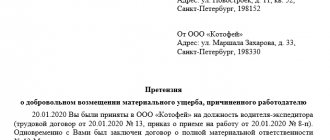Today, the Plenum of the Supreme Court adopted a draft resolution on cases of “crimes against the interests of the service” in commercial and other organizations. The court clarified what “substantial harm” is; clarified when criminal liability arises for causing it - and, finally, indicated what notaries, detectives and private security companies cannot do. Lawyers interviewed by Ulitsa emphasize that there is no established judicial practice in these cases, so it is premature to draw conclusions about the effectiveness of the resolution.
The concept of harm and material damage in criminal law
Material damage is also called property damage. It is defined as the harm that legal entities receive. or individuals, damage to their financial or property status, as well as the state. This usually includes loss of funds, damage or destruction of some property, etc.
According to current regulations, the amount of damage is determined as follows:
- the price of the lost object;
- the amount of expenses that are necessary to restore it;
- expenses associated with the need to restore a previously violated right;
- the amount of losses resulting from insufficient income received.
Damage to property is one of the consequences of certain offenses.
If it was caused as a result of deception or breach of trust, then it becomes a criminal offense. You can also talk about a criminal case if the amount exceeds that established by the legislation of the Russian Federation. After all, if it is insignificant, then it will only be considered an administrative offense.
How is the severity of damage determined?
The definition of damage in criminal law is presented as the harm suffered by the victim as a result of the commission of a crime against him. Types of damage in criminal law:
- large;
- significant;
- especially large.
The degree of significance of the damage is assessed based on its size. This also affects the liability that occurs in the event of an offense.
If the amount of damage received is less than 1000 rubles, then this is considered an administrative crime , and the punishment is determined under Part 1 of Art. 7.27 of the Code of Administrative Offenses of the Russian Federation, and in case of theft in the range of 1000 - 2500 rubles. the crime falls under the second part of this article.
Logically, there should be a classification of crimes in which the amount of harm ranged from 2,500 to 5,000 rubles, but it is missing. Therefore, there is some inconsistency here that has not yet been corrected.
The amount of material damage directly affects the type of punishment imposed.
What must be the amount of damage for the offender to face criminal liability? It depends on what article the criminal case is under, since it can be different in different cases. Legislators attribute this to the fact that each crime is individual in its essence, as well as to the fact that each of them has its own specifics and distinctive features.
Almost all amounts of damage received are listed in Chapter 21 of the Criminal Code of the Russian Federation, which lists crimes against property.
If we talk about offenses in the economic field, then the damage is calculated exclusively in hundreds of thousands and millions , since it is determined for legal entities. persons and .
When assessing the damage caused to a vehicle, experts are usually invited who take on the task of assessing the condition of the car. In this case, it is recommended to conduct your own independent examination.
Let's say that in the process of any offense some property was damaged. How is their value estimated? For this, either experts or citizens themselves are involved, who must present papers or sales receipts providing information about their market value.
Attention! A special system is provided for the assessment of objects of historical or cultural value. They are handled exclusively by experts. They need to determine their monetary value, as well as the significance they represent to culture and society.
Many factors are taken into account when assessing property damage.
There are also some general rules for assessing damage caused:
- the amount of theft is determined from the real price of the property on the date when the incident took place;
- if information about the value of the object is not available at the time the illegal act was committed, then experts are invited to evaluate it;
- The damage that the culprit is obliged to compensate to the victim is determined by the value of the damaged or destroyed property as of the date the decision on compensation for damage is determined.
- indexation of the value of objects at the time of execution of the court verdict is also provided;
- if there is a disagreement between the parties regarding the amount of compensation, then you can resort to the help of independent experts, but their services will most likely have to be paid for by the injured party, as the most interested.
Two sides of the crime
There are two sides to this crime - objective and subjective. The objective side is when deliberate actions were aimed precisely at ensuring that the property lost its economic and material value, which, in fact, happened.
Speaking about the subjective side, it is worth noting that this may not be a purposeful action, but a person’s disdainful attitude towards someone else’s property, which entailed a complete or partial loss of the property’s material, economic and consumer value.
In order to understand more clearly how this can happen, we will give the simplest example. A person deliberately decided to set fire to his own property, but as a result of the fire, someone else’s property was also destroyed. In this case, Article 167 of the Criminal Code of the Russian Federation applies.
Significant damage - summary of Art. 167 of the Criminal Code of the Russian Federation with comments
Significant damages in criminal law usually represent those large amounts of money that a victim has lost as a result of an offense.
The Criminal Code of the Russian Federation has Article 167, which treats intentional damage or complete destruction of other people's property in cases where the damage is assessed as significant.
It consists of two parts , the first of which talks about the offense itself, and the second about cases when it took place due to hooligan motives, for example, by arson, or when it resulted in the death of a person, or had some irreversible, serious consequences .
The danger of this act for society is that it usually causes irreversible property damage, and it can also damage cultural or other objects.
Article 167 of the Criminal Code of the Russian Federation provides for preventive measures for the intentional destruction or damage of property.
The subject of this offense is any property, which includes vehicles, houses or other real estate , except for some of their types, for damage or destruction of which criminal liability arises under other articles of the Criminal Code of the Russian Federation.
Also, this offense can act as a consequence of other offenses:
- terrorism (Article 205);
- mass riots (Article 212);
- hooliganism (Article 213);
- vandalism (Article 214);
- cruelty to animals (Article 245);
- sabotage (Article 281), etc.
Under this article, damage is determined to be significant based on the circumstances that existed at the time of the incident. Also, not only the price of the object itself is taken into account , but also the financial situation of the victim, the meaning that it had for him, the cost of its restoration.
Important! According to clause 2 Notes to Art. 158 significant damage is considered to be a total amount of at least 2,500 rubles. Otherwise, the act will not be considered criminal under this article.
Illegal request from a notary
Abuse of powers by a private notary or auditor (Article 202 of the Criminal Code) consists of committing acts “which, although directly related to the exercise of his rights and obligations, were not caused by official necessity and objectively contradicted the tasks of notarial or auditing activities, as well as those goals and the tasks for which that person has been vested with appropriate authority.”
The Supreme Court includes such actions, for example, when a notary sends an information request “for the purpose of transferring information to third parties.” Or “certifying a transaction for the alienation of real estate for the purpose of obtaining benefits and advantages for oneself or other persons or for the purpose of causing harm to other persons” - if the notary knew “that the terms of such a transaction do not correspond to the expressed will of its participants or that the participant in the transaction is not aware of it legal consequences." Another option is “the auditor submitting a knowingly false audit report.”
But at the same time, liability arises only if these acts entail socially dangerous consequences.
Peculiarities of qualification and liability for damage
When establishing the legal characteristics of an offense, as well as its composition, both the size and the degree of harm caused must be taken into account.
In this section we will look at the features of qualifications and preventive measures that are prescribed under Art. 167 of the Criminal Code of the Russian Federation.
Qualification
The occurrence of damage as a result of a crime is an objective property of the latter, the so-called criterion , which helps, among other things, to distinguish a criminal offense from an administrative one.
Typically, damage as one of the components of a crime acts as an object or objective side of the offense , since it characterizes the consequences that occurred as a result of the incident.
Very often, harm is expressed precisely as an object or subject of an offense , since it was precisely this that became the consequence that occurred as a result of the theft, damage or destruction of property.
Damage can act as an object of a crime, its subject or an objective aspect.
When characterizing the objective side of the crime, it is also considered, since it helps to most clearly determine the resulting result of the crime.
Preventive measure
When determining a preventive measure for crimes related to causing material damage, the following principle is applied in the Criminal Code of the Russian Federation: the greater the harm, the more severe the punishment is determined, and, as a rule, not one, but in combination with several sanctions (for example, a fine and a ban on holding certain positions or imprisonment with restriction of a citizen’s movements for some time).
Art. 167 of the Criminal Code of the Russian Federation provides for different forms of punishment, depending on the part of the article under which the crime was classified. Thus, under Part 1, the offender may be sentenced to the following preventive measures:
- a fine of up to 40,000 rubles. or salary for 3 months;
- compulsory work for a period of 360 hours;
- correctional labor for a year;
- forced labor for 2 years;
- arrest for 3 months;
- imprisonment for 2 years.
If the crime was determined according to the 2nd part of this article, then the court chooses from only two preventive measures:
- forced labor for a period of up to 5 years;
- imprisonment for the same period of time.
Abuse of repairs
Member of the Moscow Administration Council Konstantin Rivkin recalls that the Supreme Court has already addressed similar issues in the resolution of the Plenum on cases of abuse of official powers and exceeding official powers. Then he distinguished between abuse of power and malfeasance. The draft new resolution, according to Rivkin, “in more detail and meaningfully” explains what these compounds are.
Thus, abuse of authority (Article 201 of the Criminal Code) and abuse of authority in the execution of a state defense order (Article 201.1 of the Criminal Code) should be understood as “the commission by a person performing managerial functions in a commercial or other organization of such acts that, although they were directly related to the exercise by him of his rights and obligations, but were not caused by official necessity and objectively contradicted the legitimate interests of this commercial or other organization, as well as the goals and objectives for which this person was vested with the appropriate powers.”
Rivkin points out that the Supreme Court “as a guideline” gave examples of those cases when a person “commits actions within the scope of his powers in the absence of mandatory conditions or grounds for their commission” - if these actions entailed socially dangerous consequences. For example, it hires people who do not actually perform job duties. Or it exempts the organization’s employees from performing labor duties “with the assignment to repair an apartment or improve a home owned by the person himself or his relatives and friends.” Another option is that the criminal “makes a transaction in the absence of the necessary consent or subsequent approval of the collegial management body of the organization,” notes Konstantin Rivkin.





